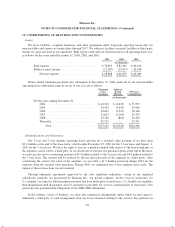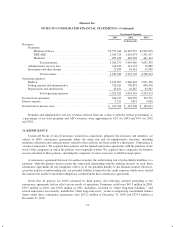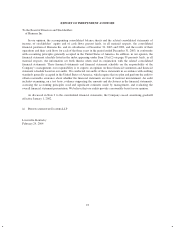Humana 2003 Annual Report Download - page 92
Download and view the complete annual report
Please find page 92 of the 2003 Humana annual report below. You can navigate through the pages in the report by either clicking on the pages listed below, or by using the keyword search tool below to find specific information within the annual report.
Humana Inc.
NOTES TO CONSOLIDATED FINANCIAL STATEMENTS—(Continued)
Stock options to purchase 4,209,266 shares in 2003, 5,050,396 shares in 2002, and 5,993,473 shares
in 2001, were not dilutive and, therefore, were not included in the computations of diluted earnings per
common share.
12. STOCKHOLDERS’ EQUITY
Stock Repurchase Plan
For the year ended December 31, 2003, we acquired 3.7 million of our common shares at an aggregate cost
of $44.1 million, or an average of $12.03 per share. Of these shares, 1.4 million were acquired in connection with
employee stock plans at an aggregate cost of $23.3 million, or an average of $16.27 per share, and the remaining
2.3 million shares were acquired in open market transactions at an aggregate cost of $20.8 million, or an average
of $9.31 per share. In July 2003, the Board of Directors authorized an additional use of up to $100 million
for the repurchase of our common shares exclusive of shares repurchased in connection with employee stock
plans. The shares may be purchased from time to time at prevailing prices in the open market or in privately
negotiated transactions. As of February 24, 2004, $94.2 million of the July 2003 authorization remains available
for share repurchases.
Stockholders’ Rights Plan
We have a stockholders’ rights plan designed to deter takeover initiatives not considered to be in the best
interests of our stockholders. The rights are redeemable by action of the Board of Directors at a price of $0.01 per
right at any time prior to their becoming exercisable. Pursuant to the plan, under certain conditions, each share of
stock has a right to acquire 1/100th of a share of Series A Participating Preferred Stock at a price of $145 per
share. This plan expires in 2006.
Regulatory Requirements
Certain of our subsidiaries operate in states that regulate the payment of dividends, loans or other cash
transfers to Humana Inc., our parent company, require minimum levels of equity, and limit investments to
approved securities. The amount of dividends that may be paid to Humana Inc. by these subsidiaries, without
prior approval by state regulatory authorities, is limited based on the entity’s level of statutory income and
statutory capital and surplus. In most states, prior notification is provided before paying a dividend even if
approval is not required.
As of December 31, 2003, we maintained aggregate statutory capital and surplus of $1,086.5 million in our
state regulated health insurance subsidiaries. Each of these subsidiaries was in compliance with applicable
statutory requirements which aggregated $640.4 million. Although the minimum required levels of equity are
largely based on premium volume, product mix, and the quality of assets held, minimum requirements can vary
significantly at the state level. Certain states rely on risk-based capital requirements, or RBC, to define the
required levels of equity. RBC is a model developed by the National Association of Insurance Commissioners to
monitor an entity’s solvency. This calculation indicates recommended minimum levels of required capital and
surplus and signals regulatory measures should actual surplus fall below these recommended levels. If RBC were
adopted by all states at December 31, 2003, each of our subsidiaries would be in compliance and we would have
$381.9 million of aggregate capital and surplus above any of the levels that require corrective action under RBC.
One TRICARE subsidiary under the Regions 3 and 4 contract with the Department of Defense is required to
maintain current assets at least equivalent to its current liabilities. We were in compliance with this requirement
at December 31, 2003.
84
























